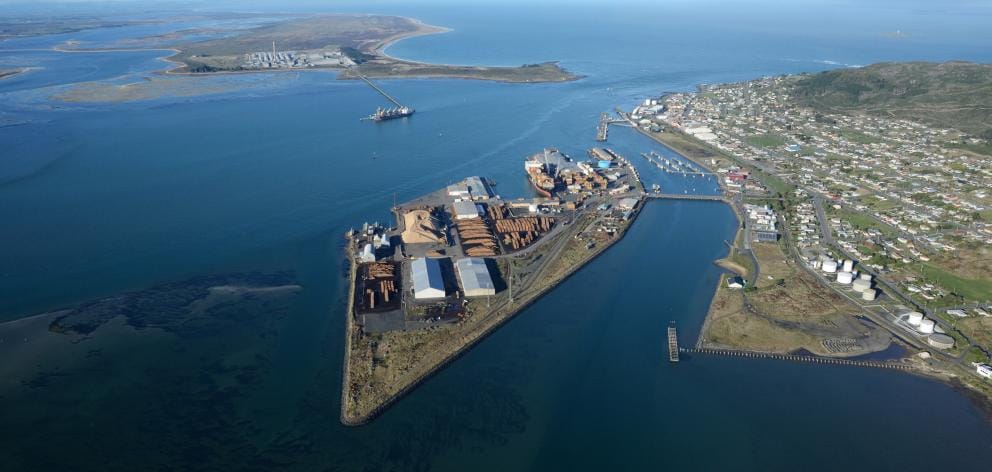
South Port New Zealand’s 2023 net profit of $11.71 million, which was up 8.7% on 2022, was “a better result” than had been expected earlier this year, shareholders were told at the company’s annual meeting at Bluff.
The normalised profit of $11.50 million was up 3% and a record result. Underlying profit has shown consistent growth over the last five years, said Chair Rex Chapman.
The company’s cargo mix of bulk cargoes, fertiliser, stock food, woodchips, and containerised freight, was down only 2.5%, despite lower container volumes being handled with fewer container vessels calling.
Around 87% of South Port’s trade is bulk cargoes; among these log exports increased 9% over the year.
The company’s prior guidance – at the time of the release of its annual report – was in the range of $11.70 to $12.30 million which would have been an increased profit compared with last year.
While well positioned in the diversified Southern region economy, the current uncertainty in international trade and slower-than-expected demand has now led South Port to temper its earnings guidance for 2024.
Mr Chapman noted that trade volumes for the first quarter of FY24 were below forecast and 10% down on the same quarter last year. The company was not immune to cyclical market changes.
“Log exports have been impacted by weaker market conditions, particularly in the main export market of China and this was signalled in our annual report. Predicting just when the Chinese market for logs might improve is difficult.”
“The farming sector across the board is going through a difficult period due to lower export prices, higher inflation, and interest rates,” he added.
“We have now seen the impact of this in the first quarter with a substantial decrease in fertiliser imports and stock food volumes are also down.”
“Containers are still facing some congestion and schedule reliability issues.”
“With so much of our volume dependent on external factors outside of our control, it is more difficult this year for us to have confidence about our earnings outlook,” said Mr Chapman.
He indicated that earnings could be at the lower end of $9 million after tax “with any upside to this dependent on a marked recovery in our bulk cargoes over the remainder of the year.”
At this stage, the board has no visibility on the timing of such a recovery.
“While we will be endeavouring to maintain the current level of dividend that will, of course, depend on no further deterioration in earnings.”
Mr Chapman said the company will be looking closely at its cost base and reducing costs where appropriate, to minimise the financial impact of this current slowdown in trade.
In FY23, South Port maintained for a second year a total dividend of 27 cents per share which represents a pay-out of 60% of net profit after tax.
In line with increased interest rates and a general weakening of the NZ equity market, the South Port share price had decreased. However, the 10-year cumulative total shareholder return shows good growth in total shareholder return.
The highlight of the year was the project to deepen the entrance channel by removing granite rock and also deepen the swinging basin in the upper harbour and berth pockets.
By using only a backhoe dredge without the need for drilling and blasting under the resource consent, the project was completed this month at approximately $7 million less than budgeted.
“The capital cost incurred will result in an enduring benefit for the Port,” said Mr Chapman.
“The business case for this project required as a minimum for us to get a return on the capex of at the very least our cost of capital. We plan to secure this through a combination of pricing and increased volume.”
“Provided we can achieve volume increases, shareholders should see a corresponding uplift in profit.”
A number of other projects have been completed this year including the Town Wharf redevelopment at a cost of $11.9 million.
The Town Wharf services the delivery of the region’s fuel and bitumen imports and its refurbishment will allow the wharf to be utilised for other users in the future including appropriately sized cruise vessels.
For the 2023-24 season, the Port already has 18 cruise vessels booked to call at Bluff.
Mr Chapman said the Port had hoped by now to have a positive decision about the smelter’s future.
“As the current closure date of December 2024 comes ever closer, the need for certainty for all stakeholders increases.”
“The case for the continuation of the smelter is more compelling than ever. The smelter is the only smelter in the world that is producing high purity aluminium from renewable energy. This fact alone should count against its closure.”
The Southern Green Hydrogen opportunity which was borne out of the potential closure of the smelter is now seen as an opportunity that can co-exist along with the smelter’s continued operation.
“This is very positive for Southland and the Port, and we expect in due course to be involved in the movement of both equipment and ammonia through the Port,” said Mr Chapman.
However, the Port was disappointed that the Ngāi Tahu project Hananui was declined fast-track consent in August this year. This application was for an open ocean salmon farm within the coastal marine area, comprising 2,500 hectares located approximately 2 to 6 km off the north-eastern coast of Stewart Island.
“The proposed marine farm had the potential to produce up to 16,000 tonnes of salmon per annum which would have doubled New Zealand’s existing production of approximately 15,000 tonnes.”
In his closing remarks, Mr Chapman reflected on the past 21 years as a South Port director and latterly Chair “as one of the most satisfying aspects of my professional career.”
He said he had “the very good fortune to work with two outstanding CEOs” in Mark O’Connor formerly and Nigel Gear, supported by a very capable executive leadership team and staff.

